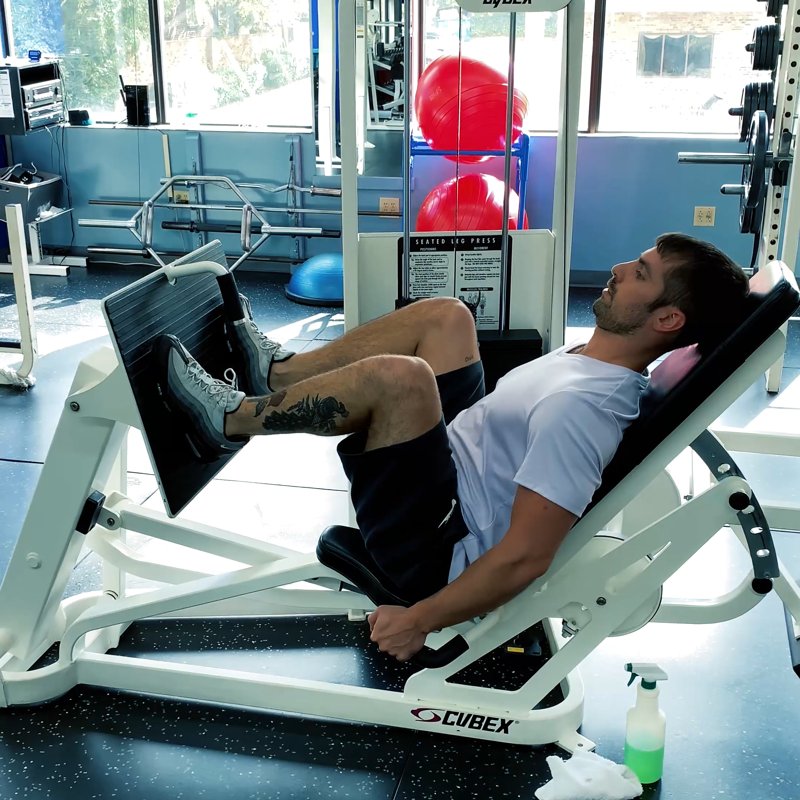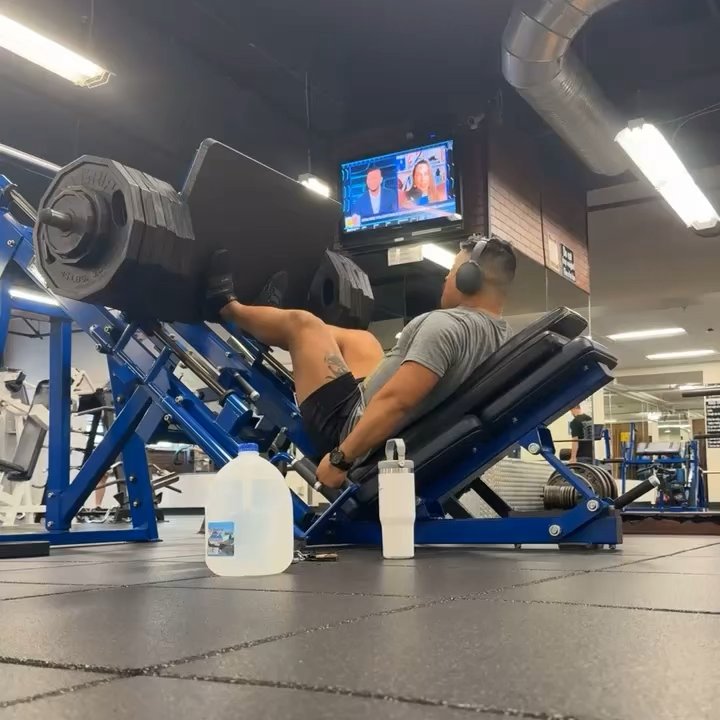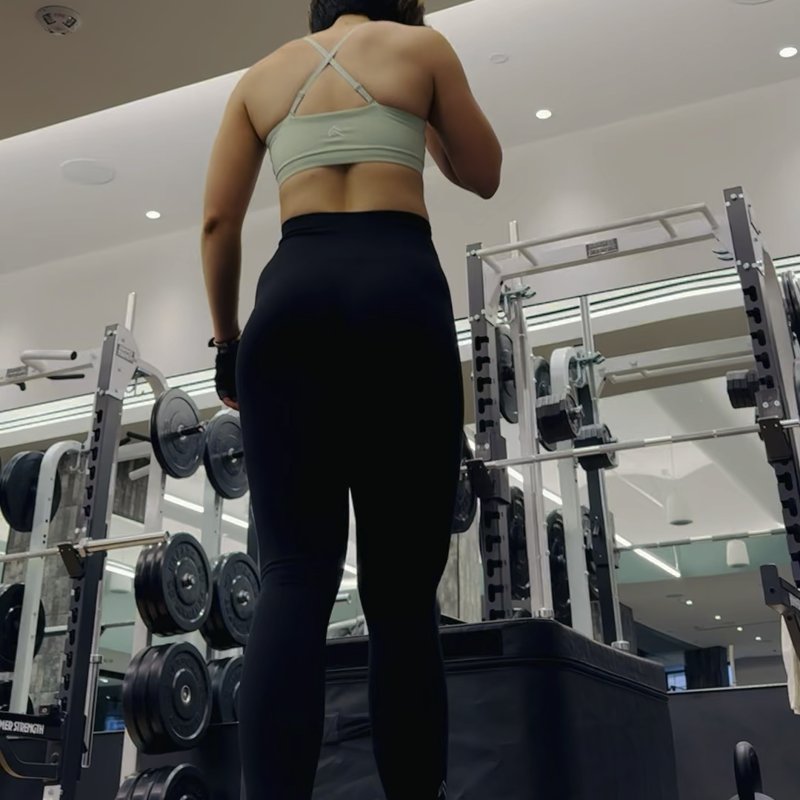Hack Squat: The Ultimate Guide
The Hack Squat Machine is a lower body exercise performed on a specialized machine where you push a weighted sled along an angled track, primarily targeting the quadriceps while placing less stress on the lower back compared to traditional squats.
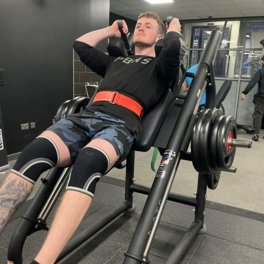
Quick Facts
Key Benefit
Quadriceps development with reduced spinal loading
Primary Muscles
Glutes, Quadriceps
Secondary Muscles
Abdominals, Erector Spinae, Hamstrings, Hip Adductors
Equipment
machine
Difficulty
Beginner
Type
Strength
In This Guide
Ready to master the Hack Squat?
Track your progress, see improvements over time, and build strength consistently.
Download GravitusThe Hack Squat Machine is a staple piece of equipment for lower body development, offering unique advantages that complement free weight squat variations. This guided machine provides a fixed movement path along an angled track, typically at around 45 degrees, allowing for focused quadriceps development with reduced technical demands.
What makes the Hack Squat particularly valuable is its ability to target the quadriceps while minimizing stress on the lower back. The supportive backrest removes much of the stabilization and balance requirements present in free weight squats, enabling greater focus on leg development for those with back concerns or technical limitations.
Additionally, the Hack Squat offers significant versatility through foot positioning. By adjusting where you place your feet on the platform, you can shift emphasis between different areas of the quadriceps, target the glutes more directly, or even increase hamstring involvement. This makes it an excellent exercise for addressing muscular imbalances or specific development goals.
Whether you're a beginner learning basic knee extension mechanics, an intermediate lifter looking to add quad-focused volume to your program, or an advanced athlete seeking to drive specific leg development while managing lower back fatigue, the Hack Squat Machine provides an effective and adaptable tool for lower body training.
Benefits of Hack Squat Machine
The Hack Squat Machine offers several advantages that make it a valuable addition to lower body training programs.
Quadriceps Emphasis
The angle and movement path strongly emphasize quadriceps development, making it excellent for building front thigh size and strength.
Reduced Spinal Loading
The supportive back pad significantly decreases compressive forces on the spine compared to free weight squats, making it accessible for those with back concerns.
Stability and Control
The guided motion eliminates many of the balance and stabilization requirements of free weight exercises, allowing greater focus on leg development.
Foot Position Versatility
Adjustable foot positioning enables targeted emphasis on different muscle groups within the lower body, from quad-focused to more glute-dominant patterns.
Loading Capacity
The machine's design typically allows for substantial loading beyond what many lifters could safely manage with free weights, enabling progressive overload.
Proper Form & Technique
Setup
- Adjust the shoulder pads on the machine to fit your height comfortably.
- Position your back flat against the back pad, with shoulders securely under the shoulder pads.
- Place your feet on the platform at approximately shoulder-width apart, with toes pointed slightly outward (about 5-15 degrees).
- Position your feet at the middle or slightly lower portion of the platform for balanced muscle recruitment.
- Grasp the side handles firmly to maintain upper body stability throughout the movement.
- Stand tall and release the safety handles or bars that keep the sled in place.
- Maintain a neutral spine position with your head aligned with your spine.
- Take a deep breath and brace your core before beginning the descent.
Movement
- Lower the sled by bending at the knees and hips simultaneously, keeping your back flat against the pad.
- Descend in a controlled manner until your knees reach approximately 90 degrees (or slightly lower if mobility allows).
- Maintain even weight distribution across your entire foot, avoiding shifting onto your toes or heels.
- At the bottom position, ensure your knees track in line with your toes, not caving inward.
- Push through your entire foot, driving the platform away as you extend your knees and hips.
- As you approach full extension, avoid forcefully locking out your knees to maintain tension on the muscles.
- Exhale during the pushing phase and inhale during the lowering phase.
- Repeat for the desired number of repetitions before engaging the safety stops.
Key Form Tips
Knee Tracking
Ensure your knees track in line with your toes throughout the movement, not caving inward (valgus) or pushing excessively outward.
Depth Control
Find a depth that allows full muscle engagement while staying within your mobility limits - typically around 90 degrees of knee flexion for most individuals.
Back Position
Keep your entire back in contact with the back pad throughout the movement, avoiding the tendency to lift your lower back as you descend.
Head Position
Maintain a neutral neck position by looking straight ahead or slightly upward, avoiding excessive looking down which can promote unwanted spinal flexion.
Foot Pressure
Drive through your full foot (mid-foot), rather than pushing predominantly through your toes or heels, for optimal force production and muscle recruitment.
Muscles Worked
Primary Muscles
- Quadriceps: The four muscles on the front of the thigh (rectus femoris, vastus lateralis, vastus medialis, vastus intermedius) that extend the knee joint and are the primary movers in this exercise.
- glutes: The largest of the gluteal muscles, involved in hip extension during the upward phase of the movement.
Secondary Muscles
- hip adductors: The inner thigh muscles that provide stability and assist with lower body coordination during the movement.
- Soleus: The deeper calf muscle that assists with knee stabilization and contributes to lower leg support throughout the exercise.
- Erector Spinae: While less involved than in free weight squats, these back muscles still engage isometrically to maintain posture against the back pad.
- Hamstrings: The posterior thigh muscles that act as synergists during the movement, particularly when using deeper ranges of motion.
- abdominals: Engage isometrically to maintain stability and proper positioning throughout the exercise, though less than in free weight variations.
Common Mistakes and How to Fix Them
Lifting Lower Back Off the Pad
Allowing the lower back to lift away from the back pad during the descent, which reduces quadriceps emphasis and increases lumbar stress. Maintain conscious contact between your entire back and the pad throughout the movement. Consider using a slightly higher foot position if maintaining back contact is challenging. Focus on simultaneous knee and hip flexion rather than trying to sit straight down, which often causes the back to lift.
Inadequate Range of Motion
Not descending deep enough to fully engage the quadriceps, or dropping too deep beyond your current mobility capabilities. Aim for at least 90 degrees of knee flexion (thighs parallel to the platform) for optimal muscle development. Use the side mirrors if available to gauge depth. If deeper ranges are uncomfortable, gradually work on improving mobility over time rather than forcing positions that cause pain.
Knees Caving Inward
Allowing the knees to collapse medially (valgus position) during the ascent, which can increase knee stress and reduce quadriceps activation. Focus on actively pressing your knees outward to track in line with your toes throughout the movement. Consider using a lighter weight until proper knee tracking becomes automatic. For recurring issues, strengthening the hip external rotators with focused exercises may help correct the problem at its source.
Excessive Knee Forward Travel
Allowing the knees to translate too far forward past the toes, potentially increasing anterior knee stress. Adjust foot position slightly higher on the platform to encourage more hip flexion relative to knee flexion. Focus on sitting "back and down" rather than straight down. If ankle mobility is limited, consider placing small weight plates under your heels to maintain proper position while working on mobility.
Uneven Weight Distribution
Shifting weight primarily onto the toes or heels rather than maintaining mid-foot pressure, reducing muscle activation and force production. Focus on applying even pressure across the entire foot, with the weight centered at mid-foot. Imagine "screwing" your feet into the platform (externally rotating without actually moving them) to create proper arch support and foot stability. Consider temporarily using a lighter weight to develop proper foot pressure awareness before returning to heavier loads.
Hack Squat Machine Variations
Foot Position Variations
-

Wide-Stance Hack Squat
Placing feet wider than shoulder-width with toes pointed outward, which increases adductor and inner quad involvement while reducing depth of knee flexion.
-

Narrow Stance Hack Squat
Positioning feet closer together, typically with feet just inside shoulder-width, to increase rectus femoris and overall quad activation.
-

High-Foot-Position Hack Squat
Placing feet higher on the platform to increase glute and hamstring involvement while reducing knee stress.
-

Low-Foot-Position Hack Squat
Setting feet lower on the platform to maximize quadriceps involvement, particularly the vastus medialis, with increased knee flexion.
Technical Variations
-
Single Leg Hack Squat
Performing the movement with one leg at a time to address strength imbalances and increase the stability demands on the working leg.
-
Pulse Hack Squat
Using small, pulsing partial repetitions at the bottom range of the movement to increase time under tension in the most challenging position.
-
Tempo Hack Squat
Manipulating the speed of different phases of the movement (e.g., 4-second descent, 1-second pause, 2-second ascent) to increase time under tension.
-
Paused Hack Squat
Incorporating a 2-3 second pause at the bottom position to eliminate momentum and increase time under tension in the stretched position.
Frequently Asked Questions
Both exercises effectively build lower body strength and muscle, but they differ in several important ways. The hack squat machine provides back support and a fixed movement path, significantly reducing the stabilization and core strength requirements present in barbell squats. This makes hack squats generally more accessible for beginners and those with limited mobility or balance. The 45-degree angle of most hack squat machines creates a different loading profile compared to the vertical loading of barbell squats, typically placing greater emphasis on the quadriceps while reducing stress on the lower back. Barbell squats engage more total muscle mass, including substantial core and upper back involvement, making them potentially superior for overall strength development and caloric expenditure. However, the hack squat allows many lifters to use heavier loads specifically for their legs due to the reduced stability demands. From a skill perspective, barbell squats require greater technical proficiency and develop more transferable strength for other activities and sports. For optimal development, many successful programs include both exercises, either within the same session (often barbell squats first, followed by hack squats) or on different training days (barbell squats on primary leg days, hack squats on secondary leg days). The ideal approach depends on your specific goals, mobility limitations, equipment availability, and overall program structure.
The ideal depth for hack squats balances maximum muscle stimulation with joint health and individual mobility limitations. For most lifters, descending until the knees reach at least 90 degrees of flexion (thighs parallel to the platform) provides effective muscle stimulus while staying within safe ranges for most individuals. Research suggests that deeper ranges of motion generally stimulate greater muscle growth due to increased time under tension and stretch under load. If your mobility allows, descending slightly below parallel can increase quadriceps, glute, and hamstring development. However, depth should never come at the expense of proper form. Maintain contact between your back and the backrest throughout the movement, and ensure your lower back doesn't begin to round or "tuck under" at the bottom position. Regardless of your current depth capabilities, always control the eccentric (lowering) phase rather than dropping quickly to the bottom position. This maintains muscle tension and reduces injury risk. If you're new to hack squats or returning after a break, start with a conservative depth and gradually increase range of motion as strength and mobility improve. Some lifters with a history of knee issues may need to use a more limited range of motion, focusing on quality of movement rather than depth. Listen to your body - pain (distinct from the normal discomfort of exertion) is a signal to adjust your technique or range of motion.
The hack squat can be either beneficial or problematic for individuals with knee issues, depending on the specific condition, how the exercise is modified, and individual factors. The fixed movement path of the hack squat machine can reduce some of the shear forces present in free weight squats, potentially making it more joint-friendly for certain conditions. However, the traditional hack squat often involves significant forward knee travel, which increases compression forces on the patellofemoral joint (kneecap area).
For individuals with anterior knee pain or patellofemoral issues, several modifications can make hack squats more accessible: - Elevate foot position higher on the platform to reduce forward knee travel and increase hip involvement relative to knee involvement - Use a more limited range of motion, stopping before the point where pain begins, and gradually increase depth as tolerance improves - Incorporate a wider stance with toes turned slightly outward to change the alignment of forces through the knee joint - Consider using lighter loads with higher repetitions rather than maximal weights that might aggravate symptoms - Add supportive equipment like knee sleeves that provide compression and warmth to the joint
Always communicate with healthcare providers about specific exercise modifications for your condition. Many physical therapists actually incorporate modified hack squats into rehabilitation programs once the acute phase of injury has passed. If hack squats consistently cause pain despite modifications, there are numerous alternative exercises like belt squats, leg presses, or Spanish squats that might better suit your needs while still effectively training the quadriceps.
Video Demonstrations
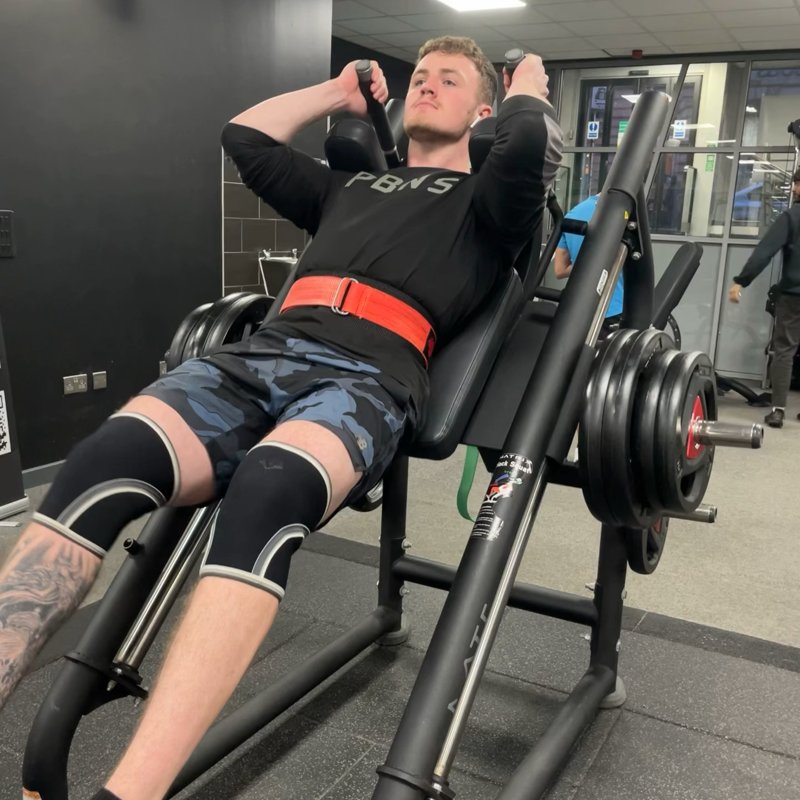
Log in to watch video demonstrations
Login to Watch3 video demonstrations available
Track your progress with Gravitus
Download Gravitus to log your workouts, track your progress, and join a community of fitness enthusiasts.

Helpful Resources
One Rep Max Calculator
Find your one rep max for any exercise without maximal testing. Essential for developing effective strength training programs.
Calculate 1RMWorkout Programs
Follow structured workout programs created by fitness professionals to maximize your strength and muscle gains.
View Programs
